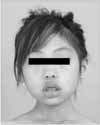Abstract
An 11-year-old girl with early-onset facioscapulohumeral muscular dystrophy (FSHD) presented with progressive gait disturbance and lumbar hyperlordosis. The motor power of her pelvic extensor muscles was grade 3. Pelvic tilt and hip flexion were markedly increased as determined by gait analysis. This FSHD case is an impressive example of a patient demonstrating the concept that weak pelvic extensor muscles cannot keep the spine upright and balanced. The most important factor in the development of hyperlordosis is the weakness of the pelvic extensor muscles, and the results of gait analysis exquisitely explain the pathophysiology. The patient stands with her spine hyperextended to maintain upright posture by a compensatory mechanism of relatively strong back extensor muscles. Corrective surgery for lumbar hyperlordosis was not considered as it could eliminate the compensatory lumbar hyperextension, thus making the spine of the patient stoop forward through the hip joint during walking, being caused by the weakness of her pelvic extensor muscles.
Figures and Tables
Fig. 1
Facial photograph showing bifacial weakness. Note the inability of the patient to close her mouth completely.

Fig. 2
Lateral and posterior photographs with the patient standing demonstrate the extremely marked lumbar lordosis with the hands clasped on the posterior hip region for support. This clinical appearance is virtually pathognomonic for early-onset FSHD. Scapular winging is evident in the back view of the patient. Standing radiographs show lumbar hyperlordosis and a horizontal sacrum (arrow).

Fig. 4
The result of gait analysis. Anterior pelvic tilt increased so severely that it could not be visualized.

Fig. 5
The mechanism of hyperlordosis in this case. The weakness of the pelvic extensor muscles brings about secondary hip flexion contracture (A), and compensatory lumbar hyperlordosis follows (B). Although the lumbar deformity can be corrected surgically or with a brace, stooping will become more severe as the weak pelvic extensor muscles are not be able to overcome the stooping of the pelvis and trunk.

References
1. Brooke MH. Clinical examination of patients with neuromuscular disease. Adv Neurol. 1977. 17:25–39.
2. Brouwer OF, Padberg GW, Wijmenga C, Frants RR. Facioscapulohumeral muscular dystrophy in early childhood. Arch Neurol. 1994. 51:387–394.

3. Dorobek M, Kabzinska D. A severe case of facioscapulohumeral muscular dystrophy (FSHD) with some uncommon clinical features and a short 4q35 fragment. Eur J Paediatr Neurol. 2004. 8:313–316.

4. Felice KJ, Jones JM, Conway SR. Facioscapulohumeral dystrophy presenting as infantile facial diplegia and late-onset limb-girdle myopathy in members of the same family. Muscle Nerve. 2005. 32:368–372.

5. Lee CS, Lee CK, Kim YT, Hong YM, Yoo JH. Dynamic sagittal imbalance of the spine in degenerative flat back: significance of pelvic tilt in surgical treatment. Spine. 2001. 26:2029–2035.
6. Miura K, Kumagai T, Matsumoto A, et al. Two cases of chromosome 4q35-linked early onset facioscapulohumeral muscular dystrophy with mental retardation and epilepsy. Neuropediatrics. 1998. 29:239–241.

7. Padberg GW, Lunt PW, Koch M, Fardeau M. Diagnostic criteria for facioscapulohumeral muscular dystrophy. Neuromusc Disord. 1991. 1:231–234.

8. Shapiro F, Specht L, Korf BR. Locomotor problems in infantile facioscapulohumeral muscular dystrophy. Retrospective study of 9 patients. Acta Orthop Scand. 1991. 62:367–371.

9. Song EW, Lenke LG, Schoenecker PL. Isolated thoracolumbar and lumbar hyperlordosis in a patient with cerebral palsy. J Spinal Disord. 2000. 13:455–460.

10. Vialle R, Khouri N, Guillaumat M. Lumbar hyperlordosis in cerebral palsy: anatomic analysis and surgical strategy for correction. Childs Nerv Syst. 2005. 22:704–709.




 PDF
PDF ePub
ePub Citation
Citation Print
Print



 XML Download
XML Download